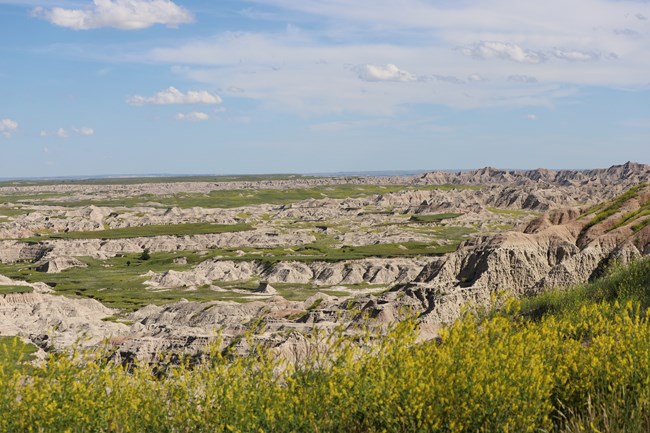Part of a series of articles titled Badlands Geology and Paleontology.
Article
A Sod Story: Ancient Prairies of the Badlands

NPS Photo

NPS Photo
Setting the Table
Throughout the Badlands are broken sections of grass and soil that sit on top of badlands material, like in the picture below. These features are known as sod tables, for the sod (or soil) that covers them and their flat, table-like tops. The soil and grass of sod tables protect the rock below from erosion by soaking up rain during intense storms, while the exposed rock around sod tables cannot absorb water and quickly washes away. The different rates of erosion make it appear like sod tables are springing up out of the Badlands, when they are really wearing away more slowly than the rock around them.

NPS Photo
Ancient prairies
Sod tables are the last traces of ancient prairies. At the end of the last ice age, the Badlands had a cooler and wetter climate. At that time, many sections of the park that today are exposed rock would have been covered by extensive prairies. As the environment slowly warmed and dried, erosion (caused by storms and flowing rivers) began to cut channels into these prairies. Once the protective layer of sod was removed, the rock beneath began quickly eroding away. In this way, the broad grasslands of the past became the isolated sod tables of today.

NPS Photo
Treasure Troves
Most of the archaeological sites found in Badlands National Park have been discovered in sod tables, such as those surrounding the Ancient Hunters Overlook. Tools, pottery, charcoal fragments, and butchered bison bones from ancient inhabitants of the Badlands are preserved in the sod -- some up to 12,000 years old! These sites are invaluable clues for understanding the history of human habitation in the Badlands, and become exposed as erosion wears away the edges of sod tables.

NPS Photo
Future Tables
Along many sections of the Badlands Loop Road, an unbroken prairie stretches away to the north of the Badlands Wall. As erosion continues to strip away the rocks of the Badlands, that prairie is likely to become dissected and fragmented, with small pockets of remaining grasslands standing above the eroded badlands below -- new sod tables! From the Pinnacles overlook, the spectacular view of canyons and sod tables to the south is a vision of what the grassland to the north will become.
Last updated: November 10, 2020
